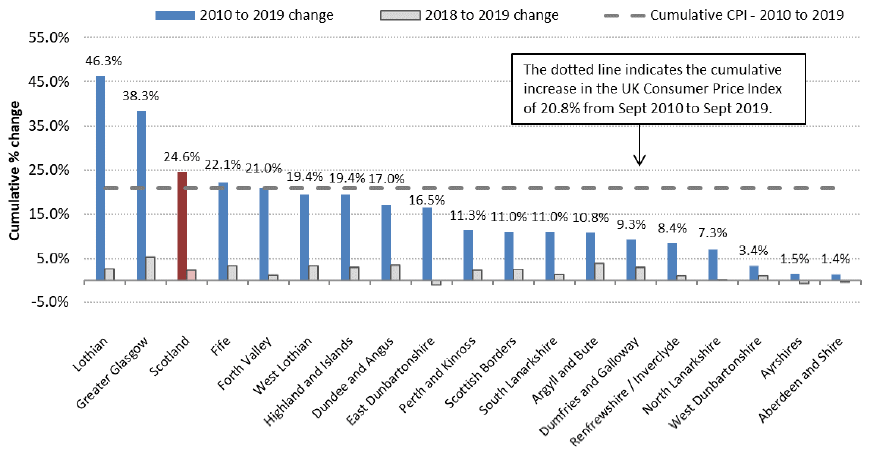Private sector rent statistics: 2010 - 2019
This publication presents statistics on private sector rent levels in Scotland over the years 2010 to 2019.
Private Sector Rent Statistics, Scotland, 2010 to 2019
Main findings for average rent changes in the latest year (2018 to 2019)
- 15 out of 18 areas of Scotland saw increases in average 2 bedroom private rent levels between 2018 and 2019 (years to end Sept), ranging from 0.2% in North Lanarkshire up to 5.3% in Greater Glasgow. Average rents fell in 3 areas, including Aberdeen and Shire where rents fell by 0.3%, the fifth consecutive annual decrease.
- These regional trends combine to show a 2.4% increase in average 2 bedroom monthly rents at a Scotland level from £652 in 2018 to £668 in 2019.
- At a Scotland level there were also increases in average rents across all other property sizes, with increases in 1 bedroom (1.9%), 3 bedroom (0.2%), 4 bedroom (3.7%) and 1 bedroom shared properties (2.0%) average rents.
- These increases compare to UK CPI inflation of 1.7% in the year to Sept 2019.
Main findings for average rent changes between 2010 and 2019
- Lothian and Greater Glasgow have seen average rents increase above the rate of inflation between 2010 and 2019 across all property sizes.
- Forth Valley and Fife have seen average rents rise above the rate of inflation for property sizes except 1 bedroom properties.
- Argyll and Bute, Dumfries and Galloway and North Lanarkshire have seen average rents rise less than the rate of inflation for all property sizes between 2010 and 2019.
Chart 1 Cumulative % Change in Average (mean) Rents from 2010 to 2019 (years to end-Sept), by Broad Rental Market Area - 2-Bedroom Properties

This publication presents statistics on private sector rent levels in Scotland over the years 2010 to 2019 (years to end-September) for different property sizes across each of the 18 Broad Rental Market Areas in Scotland[1]. It contains information on average rents as well as rents at the higher and lower end of the market[2]. The publication uses data from the Rent Service Scotland market evidence database, which is collected for the purposes of determining annual Local Housing Allowance levels and Local Reference Rent.
Note that the rental information contained in the market evidence database is largely based on advertised rents, therefore it is important to note that the statistics presented in this publication do not represent rent increases for existing tenants.
It is also important to note that the data collected on individual rents may encompass different property types and addresses for each data collection year, and that this publication is not an attempt at providing a case-matched, tracked-sample or weighted-index approach to monitoring changes to rent levels over time. See Annex D for further information on methodological differences to the ONS Index of Private Rents.
Main findings for 2 bedroom properties
The most common type of property in the private rented sector is a 2 bedroom property, with nearly half (49 per cent) of all private rented properties in Scotland estimated to be this size[3]. Findings relating to other types of properties can be different to those for 2 bedroom properties, and information on them is provided later in this publication.
- From 2018 to 2019, 15 out of 18 Broad Rental Market Areas of Scotland have seen increases in average rents for 2 bedroom properties. These have ranged from 0.2% in North Lanarkshire, up to 5.3% in Greater Glasgow. Aberdeen and Shire saw a decrease of 0.3%, the fifth consecutive annual decrease, which is likely to reflect decreased demand for rental properties in recent years following the downturn in the oil industry. The Ayrshires also saw a decrease in the latest year of 0.7%, and East Dunbartonshire showed a decrease of 1.0%.
- These regional trends combine to show an increase of 2.4% in average rents for 2 bedroom properties from £652 in 2018 to £668 in 2019. This compares to an increase in the UK Consumer Price Index of 1.7% in the year to Sept-19[4].
- For the year to end-September 2019, Lothian had the highest average monthly rents for 2 bedroom properties across Scotland (£972). Other areas with high rents included Greater Glasgow (£780), East Dunbartonshire (£677), Aberdeen and Shire (£652) and West Lothian (£630). Areas with the lowest average rents for 2 bedroom properties included the Ayrshires (£471), Dumfries and Galloway (£476), North Lanarkshire (£488), and the Scottish Borders (£490).
- Figures on changes to rents over the period from 2010 to 2019 should be considered in the context of the cumulative increase in the UK Consumer Price Index of 20.8% from Sept-10 to Sept-19[5]. For example, over the 9 year period, average rents for 2 bedroom properties in Lothian, Greater Glasgow, Fife and Forth Valley have risen faster than the consumer price index, whilst changes in average rents for 2 bedroom properties in other areas of the country have been below the rise in the consumer price index.
- These regional trends over the 9 year period combine to show a 24.6% cumulative increase in average monthly rents from £536 in 2010 to £668 in 2019 for 2 bedroom properties at the Scotland level.
The changes in average rents for 2 bedroom properties between 2018 to 2019, and 2010 to 2019, are illustrated in the maps in Figure A and Figure B, respectively.
Figure A: Change in average (mean) rents for 2 bedroom properties between 2018 and 2019.

Figure B: Percentage change in average (mean) rents for 2 bedroom properties between 2010 and 2019.

Contact
Email: felix.palin@gov.scot
There is a problem
Thanks for your feedback